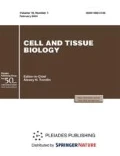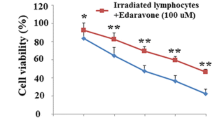Abstract
It was established that UV light (240–390 nm) at doses of 151, 1510, and 3020 J/m2; reactive oxygen species (ROS); and singlet oxygen induce the DNA fragmentation of human lymphocytic cells 20 h after exposure. Using DNA comet assay, DNA damage (monostrand breaks) has been revealed to occur immediately after the UV irradiation of lymphocytes at doses of 1510 and 3020 J/m2 or after the addition of hydrogen peroxide at a concentration of 10−6 mol/l (type-C1 comets) and to reach a maximum 6 h after action on cells of UV light or ROS (type-C2 and -C3 comets). A suggestion has been made about the leading role of the p53-dependent pathway in apoptosis in human lymphocytes under the conditions of the action of UV light and ROS.
Similar content being viewed by others
References
Aragane, Y., Kulms, D., Metze, D., Wilkes, G., Pöppelmann, B., Luger, T.A., and Schwarz, T., Ultraviolet Light Induces Apoptosis via Direct Activation of CD95 (Fas/APO-1) Independently of Its Ligand CD95L, J. Cell. Biol., 1998, vol. 140, pp. 171–182.
Artyukhov, V.G., Nakvasina, M.A., Trubitsyna, M.S., Popova, T.N., and Iskusnykh, I.Yu., Receptor Caspase-Dependent and Caspase-Independent Ways of Human Lymphocytes Apoptosis Induced by UV-radiation, Radiats. Biol. Radioekol., 2009, vol. 49, no. 4, pp. 432–437.
Attardi, L.D., Reczek, E.E., Cosmas, C., Demicco, E.G., McCurrach, M.E., Lowe, S.W., and Jacks, T., PERP, an Apoptosis-Associated Target of p53, Is a Novel Member of the PMP-22/gas3 Family, Genes Dev., 2000, vol. 14, pp. 704–718.
Bourdon, J.C., Renzing, J., Robertson, P.L., Fernandes, K.N., and Lane, D.P., Scotin, a Novel P53-Inducible Proapoptotic Protein Located in the ER and the Nuclear Membrane, J. Cell Biol., 2002, vol. 158, pp. 235–246.
Boyce, N.W. and Holdsworth, S.R., Hydroxyl Radical Mediation of Immune Renal Injury by Desferrioxamine, Kidney Int., 1986, vol. 30, pp. 813–817.
Caricchio, R., Reap, E.A, and Cohen, P.L., Fas/Fas Ligand Interactions Are Involved in Ultraviolet-B-Induced Human Lymphocyte Apoptosis, J. Immunol., 1998, vol. 161, pp. 241–251.
Chumakov, V.N. and Osinskaya, L.F., A Quantitative Method for Determining the Activity of Zinc-, Copper-Dependent Superoxide Dismutase in Biological Material, Vopr. Med. Khim., 1977, vol. 5, pp. 712–716.
Collins, A.R., Ma, A.G., Duthie, S.J., The Kinetics of Repair of Oxidative DNA Damage (Strand Breaks and Oxidised Pyrimidine) in Human Cells, Mutat Res., 1995, vol. 336, pp. 69–77.
Curnutte, J.T. and Babior, B.M., Biological Defense Mechanisms. The Effect of Bacteria and Serum on Superoxide Production by Granulocytes, J. Clin. Invest., 1974, vol. 53, pp. 1662–1672.
Dudnik, L.B., Tsyupko, A.N., Khrenov, A.V., and Alesenko, A.V., Effect of Bilirubin on Lipid Peroxidation, Sphingomyelinase Activity, and Apoptosis Induced by Sphingosine and UV Irradiation, Biokhimiya, 2001, vol. 66, no. 9, pp. 1252–1262.
Fiscella, M., Zhang, H., Fan, S., Sakaguchi, K., Shen, S., Mercer, W.E., Vande Woude, G.F., O’Connor, P.M., and Appella, E., Wip1, a Novel Human Protein Phosphatase That Is Induced in Response to Ionizing Radiation in a p53-Dependent Manner, Proc. Natl. Acad. Sci. USA, 1997, vol. 94, pp. 6048–6053.
Fortin, A., Cregan, S.P., MacLaurin, J.G., Kushwaha, N., Hickman, E.S., Thompson, C.S., Hakim, A., Albert, P.R., Cecconi, F., Helin, K., Park, D.S., and Slack, R.S., APAF1 Is a Key Transcriptional Target for P53 in the Regulation of Neuronal Cell Death, J. Cell Biol., 2001, vol. 155, pp. 207–216.
Goldstein, S. and Czapski, G., Mannitol as an OH· Scavenger in Aqueous Solutions and in Biological Systems, Int. J. Radiat. Biol., 1984, vol. 46, pp. 725–729.
Gottlieb, T.M. and Oren, M., P53 and Apoptosis, Semin. Cancer Biol., 1998, vol. 8, pp. 359–368.
Hartmann, A., Agurell, E., Beevers, C., Brendler-Schwaab, S., Burlinson, B., Clay, P., Collins, A., Smith, A., Speit, G., Thybaud, V., and Tice, R.R., Recommendations for Conducting the in vivo Alkaline Comet Assay, Mutagenesis, 2003, vol. 18, pp. 45–51.
Hwang P. M., Bunz F., Yu J., Rago C., Chan T. A., Murphy M.P., Kelso G.F., Smith R.A., Kinzler K.W., Vogelstein B. Ferredoxin Reductase Affects p53-dependent, 5-fluorouracil-induced Apoptosis in Colorectal Cancer Cells. Nat. Med. 2001, vol. 7, pp. 1111–1117.
Kulms, D. and Schwarz, T., Molecular Mechanisms of UV-Induced Apoptosis, Photodermatol. Photoimmunol. Photomed., 2000, vol. 16, pp. 195–201.
Lin, Y., Ma, W., and Benchimol, S., Pidd, a New Death-Domain-Containing Protein, Is Induced by P53 and Promotes Apoptosis, Nat. Genet., 2000, vol. 26, pp. 122–127.
Lonskaya, I.A., Afanas’ev, V.N., Pechatnikov, V.A., Induction and Suppression of Apoptosis in Rat Thymocytes by Ultraviolet Irradiation, Biofizika, 1997, vol. 42, no. 3, pp. 680–685.
Martin, S.J. and Gotter, T.G., Ultraviolet B Irradiation of Human Leukaemia HL-60 Cells in vitro Induces Apoptosis, Int. J. Radiat. Biol., 1991, vol. 59, pp. 1001–1016.
Men’shchikova, E.B. and Zenkov, N.K., Oxidative Stress in Inflammation, Usp. Sovr. Biol., 1997, vol. 117, no. 2, pp. 155–157.
Mironov, A.F., Photodynamic Therapy of Cancer—A New Effective Method for Diagnosing and Treatment of Malignant Tumors, Soros. Obrazovat. Zh., 1996, vol. 2, no. 8, pp. 32–40.
Miyashita, T. and Reed, J.C., Tumor Suppressor p53 Is a Direct Transcriptional Activator of the Human bax Gene, Cell, 1995, vol. 80, pp. 293–299.
Moroni, M.C., Hickman, E.S., Lazzerini Denchi, E., Caprara, G., Colli, E., Cecconi, F., Muller, H., and Helin, K., Apaf-1 Is a Transcriptional Target for E2F and p53, Nat. Cell Biol., 2001, vol. 3, pp. 552–558.
Murahashi, H., Azuma, H., Zamzami, N., Furuya, K., Ikebuchi, K., Yamaguchi, M., Yamada, Y., Sato, N., Fujihara, M., Kroemer, G., and Ikeda, H., Possible Contribution of Apoptosis-Inducing Factor (AIF) and Reactive Oxygen Species (ROS) to UVB-Induced Caspase-Independent Cell Death in the T Cell Line Jurkat, J. Leukocyte Biol., 2003, vol. 73, pp. 399–406.
Nakamura, Y., Isolation of p53-Target Genes and Their Functional Analysis, Cancer Sci., 2004, vol. 95, pp. 7–11.
Nakano, K. and Vousden, K.H., Puma, a Novel Proapoptotic Gene, Is Induced by p53, Mol. Cell, 2001, vol. 7, pp. 683–694.
Oda, E., Ohki, R., Murasawa, H., Nemoto, J., Shibue, T., Yamashita, T., Tokino, T., Taniguchi, T., and Tanaka, N., Noxa, a BH3-Only Member of the Bcl-2 Family and Candidate Mediator of P53-Induced Apoptosis, Science, 2000b, vol. 288, pp. 1053–1058.
Oda, K., Arakawa, H., Tanaka, T., Matsuda, K., Tanikawa, C., Mori, T., Nishimori, H., Tamai, K., Tokino, T., Nakamura, Y., and Taya, Y., p53AIP1, a Potential Mediator of P53-Dependent Apoptosis, and Its Regulation by Ser-46-Phosphorylated p53, Cell, 2000a, vol. 102, pp. 849–862.
Olive, P.L., Banath, J.P., and Durand, R.E., Heterogeneity in Radiation-Induced DNA Damage and Repair in Tumor and Normal Cells Measured Using the “Comet” Assay, Radiat. Res., 1990, vol. 122, pp. 86–94.
Ostling, O. and Johanson, K.J., Microelectrophorettic Study of Radiation-Induced DNA Damage in Individual Mammalian Cells, Biochem. Biophys. Res. Commun., 1984, vol. 123, pp. 291–298.
Owen-Schaub, L.B., Zhang, W., Cusack, J.C., Angelo, L.S., Santee, S.M., Fujiwara, T., Roth, J.A., Deisseroth, A.B., Zhang, W.W., Kruzel, E., and Radinsky, R., Wild-Type Human P53 and a Temperature-Sensitive Mutant Induce Fas/APO-1 Expression, Mol. Cell Biol., 1995, vol. 15, no. 6, pp. 3032–3040.
Ozawa, B.M., Ferenczi, K., Kikuchi, T., Cardinale, I., Austin, L.M., Coven, T.R., Burack, L.H., and Krueger, J.G., 312-Nanometer Ultraviolet B Light (Narrow-Band UVB) Induces Apoptosis of T Cells within Psoriatic Lesions, Exp. Med., 1999, vol. 189, pp. 711–718.
Pletjushkina, O.Yu., Fetisova, E.K., Lyamzaev, K.G., Ivanova, O.Yu., Domnina, L.V., Vysokikh, M.Yu., Pustovidko, A.V., Alekseevski, A.V., Alekseevski, D.A., Vasil’ev, Yu.M., Murphy, M.P., Chernyak, B.V., and Skulachev, V.P., Hydrogen Peroxide Produced Inside Mitochondria Takes Part in Cell-to-Cell Transmission of Apoptotic Signal, Biokhimiya, 2006, vol. 71, no. 1, pp. 75–84.
Polyak, K., Xia, Y., Zweier, J.L., Kinzler, K.W., and Vogelstein, B., A Model for P53-Induced Apoptosis, Nature, 1997, vol. 389, pp. 300–305.
Robles, A.I., Bemmels, N.A., Foraker, A.B., and Harris, C.C., APAF-1 Is a Transcriptional Target of p53 in DNA Damage-Induced Apoptosis, Cancer Res., 2001, vol. 61, pp. 6660–6664.
Roos, D., The Metabolic Response to Phagocytosis, in The Cell Biology of Inflammation, Amsterdam: Elsevier, 1980, vol. 2, pp. 337–385.
Rvachev, V.P., Vvedenie v biofizicheskuyu fotometriyu (Introduction to Biophysical Photometry), Lvov, 1966.
Servomaa, K. and Rytomaa, T., UV Light and Ionizing Radiations Cause Programmed Death of Rat Chlorleukemia Cells by Inducing Retropositions of a Mobile DNA Element (L1Rn), Int. J. Radiat. Biol., 1990, vol. 57, pp. 331–343.
Singh, N.P., McCoy, M.T., Tice, R.R., and Schneider, E.L., A Simple Technique for Quantitation of Low Levels of DNA Damage in Individual Cells, Exp. Cell Res., 1988, vol. 175, pp. 184–191.
Sirota, N.P. and Kuznetsova, E.A., The Level of Spontaneous DNA Lesions in Peripheral Blood Leukocytes of People of Different Age, Byull. Eksp. Biol. Med., 2008, vol. 145, no. 2, pp. 154–156.
Skulachev, V.P., The Phenomena of Programmed Death. Mitochondria, Cells, and Organs: The Role of Reactive Oxygen Species, Soros. Obrazovat. Zh., vol. 7, no. 6, pp. 4–10.
Steinbeck, M.J., Khan, A.U., and Karnovsky, M.J., Intracellular Singlet Oxygen Generation by Phagocytosing Neutrophils in Response to Particles Coated with a Chemical Trap, J. Biol. Chem., 1992, vol. 267, pp. 13425–13433.
Tronov, V.A. and Pelevina, I.I., The DNA-Comet Method for Individual Cells. The Principle and Use of the Method, Tsitologiia, 1996, vol. 38, no. 4/5, pp. 631–641.
Tronov, V.A., Tereshchenko, D.G., and Konoplyannikov, M.A., Mechanism of Radiation Death of Human Peripheral Blood Lymphocytes, Assessed by the DNA-Comet Method, Biofizika, 1998, vol. 43, no. 1, pp. 115–124.
Vladimirskaya, E.B., Apoptosis and Its Role in the Regulation of Cell Equilibrium (A Lecture), Klin. Labor. Diagn., 2002, vol. 11, pp. 25–33.
Vousden, K.H. and Lu, X., Live or Let Die: The Cell’s Response to p53, Nat. Rev. Cancer, 2002, vol. 2, pp. 594–604.
Vousden, K.H., p53. Death Star, Cell, 2000, vol. 103, pp. 691–694.
Wu, G.S., Burns, T.F., McDonald, E.R., 3rd, Jiang, W., Meng, R., Krantz, I.D., Kao, G., Gan, D.D., Zhou, J.Y., Muschel, R., Hamilton, S.R., Spinner, N.B., Markowitz, S., Wu, G., and el-Deiry, W.S., KILLER/DR5 Is a DNA Damage-Inducible p53-Regulated Death Receptor Gene, Nat. Genet., 1997, vol. 17, pp. 141–143.
Yu, J., Zhang, L., Hwang, P.M., Kinzler, K.W., and Vogelstein, B., PUMA Induces the Rapid Apoptosis of Colorectal Cancer Cells, Mol. Cell., 2001, vol. 7, pp. 673–682.
Author information
Authors and Affiliations
Corresponding author
Additional information
Original Russian Text © V.G. Artyukhov, M.S. Trubitsyna, M.A. Nakvasina, E.V. Solov’eva, 2011, published in Tsitologiya, Vol. 53, No. 1, 2011, pp. 61–67.
Rights and permissions
About this article
Cite this article
Artyukhov, V.G., Trubitsyna, M.S., Nakvasina, M.A. et al. DNA fragmentation of human lymphocytes in dynamics of development of apoptosis induced by action of UV radiation and reactive oxygen species. Cell Tiss. Biol. 5, 127–135 (2011). https://doi.org/10.1134/S1990519X11020039
Received:
Published:
Issue Date:
DOI: https://doi.org/10.1134/S1990519X11020039



